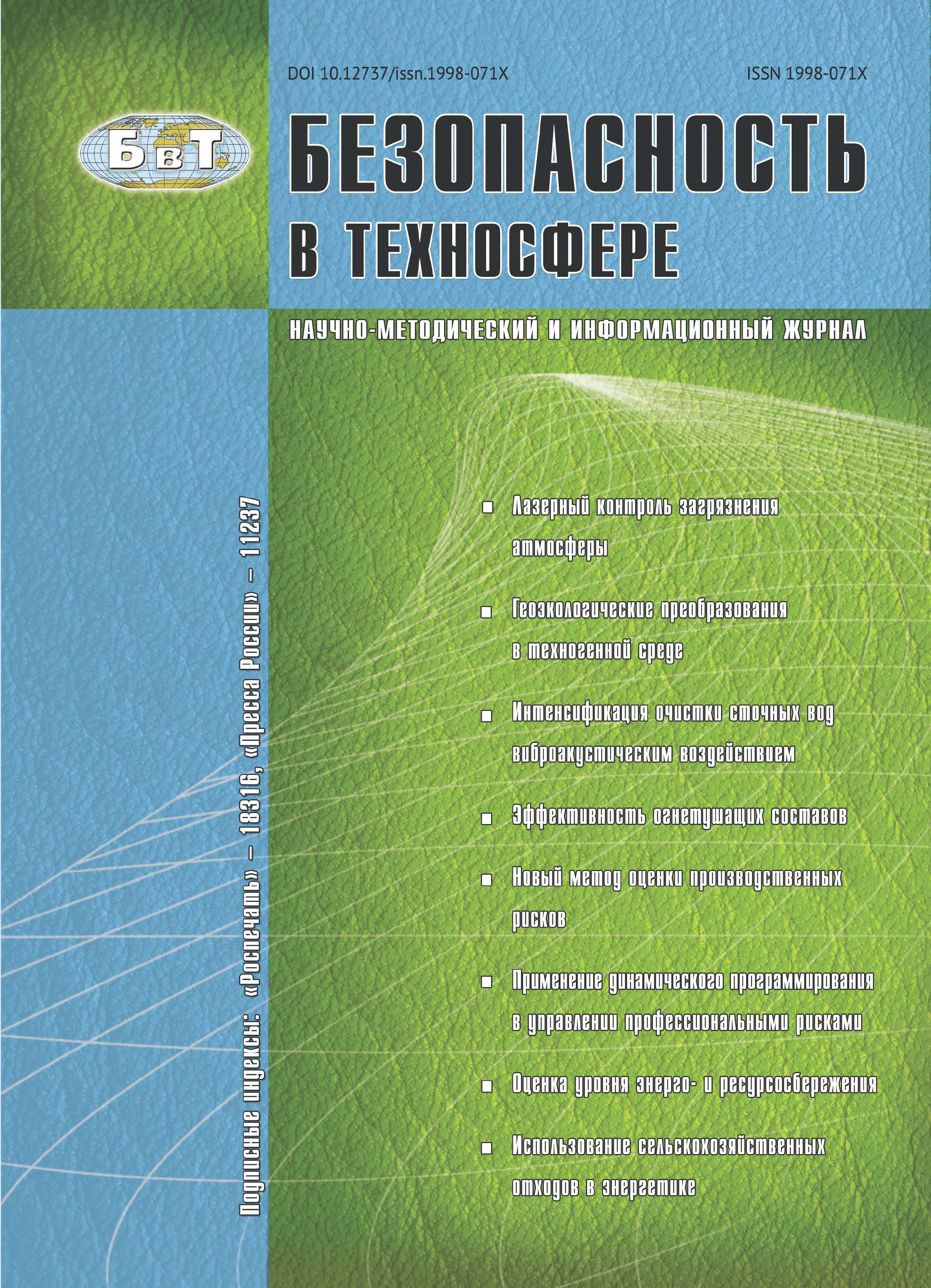from 01.01.2016 to 01.01.1921
Perm, Perm, Russian Federation
The matrix method is often used for occupational risk assessment. In this paper have been considered the matrix method’s use features, as well as have been highlighted its advantages and disadvantages. Have been presented recommendations on the risk matrix development, and criteria for categorization of occupational risk’s attributes – the effect consequences severity of hazard and its feasibility. The proposed approach to consequences severity categorization is accorded with rules and regulations regarding the severity of harm to human health, which in return facilitates mitigation the degree of uncertainty and subjectivity of the assessment results. The grading of categories for hazard feasibility is based on well-known scientific and practical approaches. Has been performed the generalization of scientific data on the hazard feasibility categorization, and have been proposed universal criteria descriptors, which allow assess the considered hazard objectively and all round, and determine the necessary category for this hazard feasibility. It has been pointed to subjective perception of categories names in final estimating of occupational risk levels, and has been proposed to use the concepts of occupational risk levels, which based on the priority relating to risk respond measures. The proposed approaches facilitate increase of quality and effectiveness of matrix method use in estimating of occupational risk levels.
occupational risk, risk assessment, occupational risk assessment, risk assessment methodology, matrix method, risk assessment matrix, consequences severity, hazard feasibility
1. Trudovoj Kodeks Rossijskoj Federacii [Labor Code of the Russian Federation]. Available at: http://www.consultant.ru/document/cons_doc_LAW_34683/ (accessed 10 February 2020). (in Russian).
2. Kodeks RF ob administrativnyh pravonarushenijah [The RF Code of Administrative Offenses]. Available at: http://www.consultant.ru/document/cons_doc_LAW_34661/ (accessed 10 February 2020). (in Russian).
3. Ob utverzhdenii Tipovogo polozhenija o sisteme upravlenija ohranoj truda : prikaz Mintruda Rossii № 438n [On approval of the Model Regulations on the Occupational Safety Management System: Order of the Ministry of Labor of Russia No. 438n]. Available at: http://docs.cntd.ru/document/420376480/ (accessed 10 February 2020). (in Russian).
4. GOST 12.0.230.4-2018. SSBT. Sistemy upravlenija ohranoj truda. Metody identifikacii opasnostej na razlichnyh jetapah vypolnenija rabot [GOST 12.0.230.4-2018. SSBT. Occupational safety management systems. Methods for identifying hazards at various stages of work]. Available at: http://docs.cntd.ru/document/1200160464/ (accessed 10 February 2020). (in Russian).
5. GOST 12.0.230.5-2018. SSBT. Sistemy upravlenija ohranoj truda. Metody ocenki riska dlja obespechenija bezopasnosti vypolnenija rabot [GOST 12.0.230.5-2018. SSBT. Occupational safety management systems. Risk assessment methods to ensure the safety of work]. Available at: http://docs.cntd.ru/document/1200160465/ (accessed 10 February 2020). (in Russian).
6. GOST R 51901.1-2002. Menedzhment riska. Analiz riska tehnologicheskih sistem (s popravkoj) [GOST R 51901.1-2002. Risk management. Risk analysis of technological systems]. Available at: http://docs.cntd.ru/document/1200030153/ (accessed 10 February 2020). (in Russian).
7. GOST R ISO 17776-2012. Neftjanaja i gazovaja promyshlennost'. Morskie dobychnye ustanovki. Sposoby i metody identifikacii opasnostej i ocenki riska. Osnovnye polozhenija [GOST R ISO 17776-2012. Oil and gas industry. Offshore mining installations. Methods and methods of hazard identification and risk assessment. Basic provisions]. Available at: http://docs.cntd.ru/document/1200103134/ (accessed 10 February 2020). (in Russian).
8. Timofeeva, S.S. Metody i tehnologii ocenki proizvodstvennyh riskov: prakticheskie raboty dlja magistrantov po napravleniju 280700 "Tehnosfernaja bezopasnost'" [Methods and technologies for assessing industrial risks: practical work for undergraduates in the direction 280700 "Technosphere safety"]. Irkutsk: IrGTU Publ., 2014. 177 p. (in Russian).
9. Ob utverzhdenii Medicinskih kriteriev opredelenija stepeni tjazhesti vreda, prichinennogo zdorov'ju cheloveka: prikaz Ministerstva zdravoohranenija i social'nogo razvitija RF № 194n [On the approval of the Medical criteria for determining the severity of harm caused to human health: order of the Ministry of Health and Social Development of the Russian Federation No. 194n]. Available at: http://docs.cntd.ru/document/902116666/ (accessed 10 February 2020). (in Russian).
10. Mogilko, D. Ju. Upravlenie riskami: model' processa i kompetencij [Risk management: a process and competence model]. Menedzhment kachestva [Quality management]. 2019, I. 3, pp. 184-199. (in Russian).
11. GOST R 58771-2019 Menedzhment riska. Tehnologii ocenki riska [GOST R 58771-2019 Risk management. Risk assessment technologies]. Available at: http://docs.cntd.ru/document/1200170253/ (accessed 10 February 2020). (in Russian).
12. Taranushina, I.I. Metod ocenki professional'nyh riskov kak jelement koncepcii bezopasnosti proizvodstva [Methods for assessing professional risks as an element of the production safety concept]. Bezopasnost' truda v promyshlennosti [Labor safety in industry]. 2019, I. 7, pp. 74-80. DOI:https://doi.org/10.24000/0409-2961-2019-7-74-80. (in Russian).
13. Occupational Health and Safety Risk Management - Procedure. Available at: https://ppl.app.uq.edu.au/content/2.30.01-occupational-health-and-safety-risk-management/ (accessed 10 February 2021).
14. Donoghue, A. M.. The design of hazard risk assessment matrices for ranking occupational health risks and their application in mining and minerals processing. Occupational Medicine, 2001, vol. 51, i. 2, pp. 118-123, https://doi.org/10.1093/occmed/51.2.118.
15. HSEMA Procedures. Available at: http://www.hsema.com.au/products/procedures/ (accessed 10 February 2021).
16. Dirk J. Pons. Alignment of the Safety Assessment Method with New Zealand Legislative Responsibilities. Safety, 2019, vol. 5 (3), i. 59; https://doi.org/10.3390/safety5030059.
17. Fine, W. T. Mathematical Evaluation for Controlling Hazards. Journal of Safety Research. 1971, vol. 3, no. 4. pp. 157-166.
18. Kinney, G.F., Wiruth, A.D. Practical Risk Analysis for Safety Management // NPS Report Number NWC-TP-5865. - Naval Weapons Center. 1976. 25 p.







